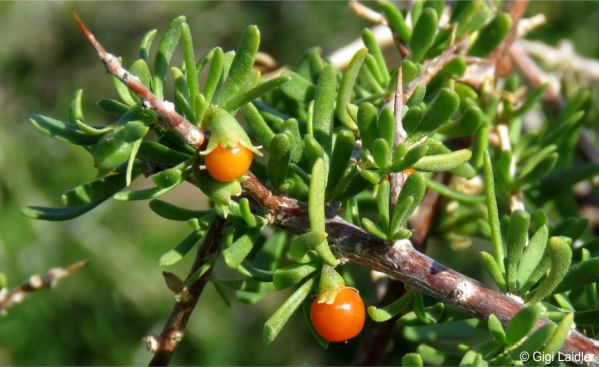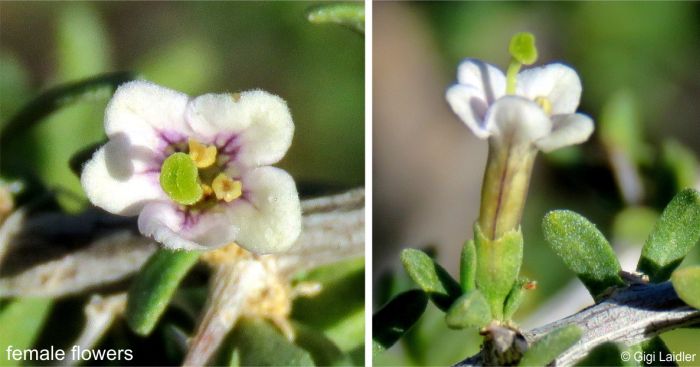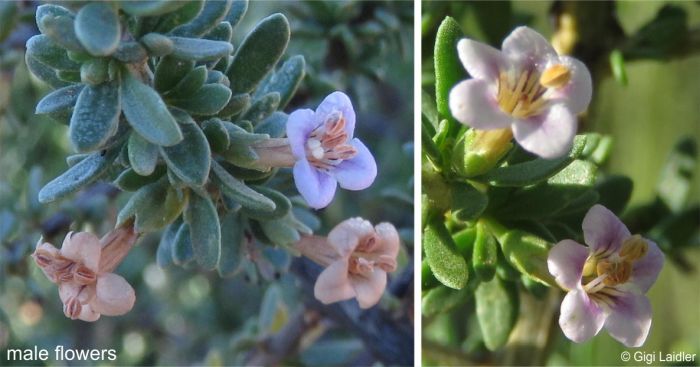Lycium horridum
Lycium horridum Thunb.
Family: Solanaceae
Common names: buck honeythorn (Eng.); bokdoring, kriedoring, kraaldoring, slangbessiebos, wolwedoring (Afr.)
SA Tree No: 669.13
Introduction
Lycium horridum, also known as the buck honeythorn, is a thorny shrub with oblong leaves and distinctive orange to red berries. The plant is known to be adaptable and hardy in many environments and it is used in traditional medicine. The thorny nature of the shrub serves as a natural defense mechanism. It is different from most of African species of Lycium because it exhibits a dioecious reproductive system.

Description
Description
Lycium horridum is characterized by its rigid structure, stout thorns, and short side branches which taper to a sharp tip. This feature serves as a defense mechanism against herbivores and other potential threats in its environment. It is a shrub that ranges from 0.2-1.8 m in height. The young stem starts off green and relatively soft, then hardens, and becomes whitish with dark streaks as they mature. The older stems are dark grey or purplish brown. Similar to many Lycium species, the leaves of L. horridum are oblong, narrowly elliptic, or linear and appear flattened and exhibit a succulent nature. The leaves are alternately arranged along the stem, and are clustered on hidden brachyblasts (short shoots), which contributes to the overall form and structure of the plant. The leaf dimensions are 7-12 mm long x 1.5-3 mm wide. Before falling off in autumn, the leaves turn yellow or golden.

The flowers of L. horridum emerge from the leaf axils. This species is dioecious with male and female flowers on separate plants. The corolla is tubular to narrowly funnel-shaped, small, the tube 6-9 mm long and 2-3 mm wide, with 5 (sometimes 4) spreading lobes at the mouth, 1.5-2 mm long, that are notably shorter than the tube. The flower is white, with a dark purple patch at the base of the lilac lobes. Male and female flowers look the same, but the female is smaller. The male has fertile stamens that only slightly protrude from the corolla mouth and no stigma. The female has infertile stamens that don’t protrude and a stigma on a long style that protrudes slightly from the corolla tube. The calyx is tubular, twice as long as wide, covering less than half of the corolla tube. Flowering usually occurs in spring and summer, but may be at different times of the year as it depends on when it rains.

The fruits are small red berries with a rounded to ovoid shape and a slightly pointed tip. The fruits become 4-6 mm long, and 3-3.5 mm when ripe. They are edible and are consumed by fruit-eating birds that disperse the seeds in their droppings. Only female plants bear fruits.
Conservation Status
Status
This species is not considered to be threatened and it is placed under Least Concern (LC) by the Red List of South African Plants.
Distribution and habitat
Distribution description
Lycium horridum is distributed in seasonally dry, arid regions with moderate to low rainfall, in temperate and subtropical Africa, occurring in Angola, Botswana, Namibia, Zimbabwe and South Africa. In South Africa it covers all provinces except, KwaZulu-Natal. It is known to thrive in sandy, karroid lowlands and floodplains, open grassland, scrub, hillsides, fallow lands, rocky slopes and along roads, adapting to various vegetation types and soil types within these ecosystems. Its ability to grow in such diverse environments contributes to its wide distribution. The plant exhibits characteristics of both deciduous and evergreen shrubs, and its spiny nature adds to its adaptability in various environments.

Derivation of name and historical aspects
History
The name of the genus Lycium comes from the Greek word lykos, which means ‘wolf’. The name may be associated with the belief that these plants were once thought to grow in areas occupied by wolves or because their spiny nature resembled the characteristics of a wolf. Dioscorides, the ancient Greek physician, pharmacologist, and botanist, originally applied the name Lycium to thorny shrubs found in Lycia, a region in Turkey. His work, De Materia Medica, written in the first century AD, is a significant early pharmacopoeia that catalogued plants with medicinal properties. This genus includes 101 recognized species. Lycium species, including L. horridum, have been recognized for their historical uses in traditional medicine.
The species name horridum comes from the Latin horridus, meaning ‘rough’ or ‘prickly’, likely describing the plant’s characteristic spines or thorns that are shorter towards the tips of the stems.
The Solanaceae, also known as the nightshade family, is a large family of flowering plants. It consists of over 90 genera and around 2 800 recognized species, with a great diversity of habitats, morphology and ecology.
Ecology
Ecology
Lycium horridum has evolved features like small, succulent leaves and a deep root system to survive water scarcity, and a spiny defensive mechanism to protect itself from herbivores. This shrub reproduces through both sexual and vegetative means. Its seeds, contained in the berries, are dispersed through ingestion by birds and other animals. It also plays a role in the ecosystem by providing habitat and food for wildlife. Birds are particularly drawn to its berries, participating in the plant’s reproductive cycle and contributing to local biodiversity. Their extensive root system assists in soil stabilization, and prevents erosion. It is primarily pollinated by bees, especially native bee species. Butterflies and other flying insects also play a role in pollination of flowers.
Lycium horridum can survive fire by resprouting from its root system or from basal buds. It has seeds that are modified to germinate in response to specific fire-related cues, such as heat or smoke. The plant’s physical characteristics, such as its woody and tough structure, may provide some protection against the heat and fire, which is intense, in addition to its strategies that allow it to grow well in areas that experience fires.
Its resilience and adaptability make it a pioneer species, often seen on disturbed land.

Uses
Use
Several parts of L. horridum are believed to have medicinal properties and are used in traditional medicine. Extracts of the plant are often used to treat various ailments or as a general health tonic. Its berries are a source of food for wildlife, attracting birds and small mammals. Its extensive root system stabilizes the soil and controls erosion. It is used for landscaping or ornamental purposes. The branches are used for traditional crafts like, basket weaving and other handmade materials.
Growing Lycium horridum
Grow
This species can be easily grown from seed and cuttings, in a sandy or loamy soil type in full sun and with little or no frost.
The seed is extracted from a ripe berry, then cleaned, and sown in moist, well-drained mixed soil and placed in a warm, and sunny spot and kept moist for germination. The seedlings should appear in few weeks.
Softwood cutting should be taken from the current season’s growth on a healthy plant, in spring or early summer. Cuttings should be 10-15 cm long with at least two leaf nodes and the lower leaves removed. The cut end is dipped in rooting hormone. The cuttings are planted in a well-drained soil mix and should be kept moist until roots develop.
Hardwood cuttings are done in late summer or autumn. They should be 15-20 cm long with all leaves removed and the cut end treated with rooting hormone. The cuttings are planted in container filled with well-drained soil and kept moist until roots form.
Lycium horridum does well in arid to semi-arid climates with full exposure to sun. It can survive in a wide range of temperatures but prefers warm conditions. It prefers well-drained soil, however it can tolerate poor soil conditions but does best in sandy or loamy soil with a pH that is slightly acidic to slightly alkaline. It is resistant to drought. It benefits from regular watering during dry periods, especially when young. It does not require heavy fertilization, a balanced fertiliser applied sparingly in spring can help promote healthy growth. It can be pruned to maintain shape and remove dead or damaged branches, this will also promote thick growth and an increase in the production of berries. It is resistant to pests and diseases, however, aphids, spider mites, and powdery mildew might affect them, and can be treated with insecticidal soap or horticultural oil when detected. Berries are harvested when they are fully ripe, mostly in late summer or autumn.
Generally, the plant is known for being a relatively slow to moderate grower and has the potential for a relatively long lifespan.
References
- Germishuizen, G. & Meyer, N.L. (eds) 2003. Plants of southern Africa: an annotated checklist. Strelitzia 14. National Botanical Institute, Pretoria.
- Laidler, G. 2024. Observations of Lycium horridum. iNaturalist. Online. https://www.inaturalist.org/observations?place_id=any&taxon_id=533347&user_id=gigilaidler.
- Latti, I. n.d. Lycium horridum. Operation Wildflower. Online. https://operationwildflower.org.za/index.php/albums/genera-i-l/lycium/lycium-horridum-thabo-6-6781#joomimg. Accessed on 2024/02/18.
- Manning, J. & Goldblatt, P. 2012. Plants of the Greater Cape Floristic Region 1: the Core Cape Flora. Strelitzia 29. South African National Biodiversity Institute, Pretoria.
- Mucina, L. & Rutherford, M.C. (eds) 2006. The vegetation of South Africa, Lesotho and Swaziland. Strelitzia 19. South African National Biodiversity Institute, Pretoria.
- Olmstead, R.G. & Bohs, L. 2007. A summary of molecular systematic research in Solanaceae: 1982-2006. Acta Horticulturae 745:255-268.
- Plants of the World Online. Lycium L. https://powo.science.kew.org/taxon/urn:lsid:ipni.org:names:30001330-2. Accessed on 13 Jun 2024.
- Raimondo, D., Von Staden, L., Foden, W., Victor, J.E., Helme, N.A., Turner, R.C., Kamundi, D.A. & Manyama, P.A. (eds) 2009. Red list of South African plants. Strelitzia 25. South African National Biodiversity Institute, Pretoria.
- Venter, A.M. 2000. Taxonomy of the genus Lycium L. (Solanaceae) in Africa. Ph.D. Thesis, Botany and Genetics, University of the Free State, Bloemfontein.
- Von Dürckheim, H., Van Wyk, B., Van den Berg, E., Coates Palgrave, M. & Jordaan, M. 2014. Pocket list of southern African indigenous trees. Briza Publication, Pretoria.
Credits
Sedzani Madongo, SANBI Groen Sebenza Intern
and Aluwani Tshiila, Scientist Production – Botanist
Department of Economic Development, Environment, Conservation and Tourism (NWDEDECT)
June 2024
Acknowledgements: images by Gigi Laidler from her observations posted on iNaturalist.
Plant Attributes:
Plant Type: Shrub
SA Distribution: Eastern Cape, Free State, Gauteng, Limpopo, Mpumalanga, North West, Northern Cape, Western Cape
Soil type: Sandy, Clay, Loam
Flowering season: Spring, Early Summer
PH: Acid, Alkaline, Neutral
Flower colour: Purple, White, Pink
Aspect: Full Sun
Gardening skill: Easy
Special Features:
Horticultural zones











Rate this article
Article well written and informative
Rate this plant
Is this an interesting plant?
Login to add your Comment
Back to topNot registered yet? Click here to register.